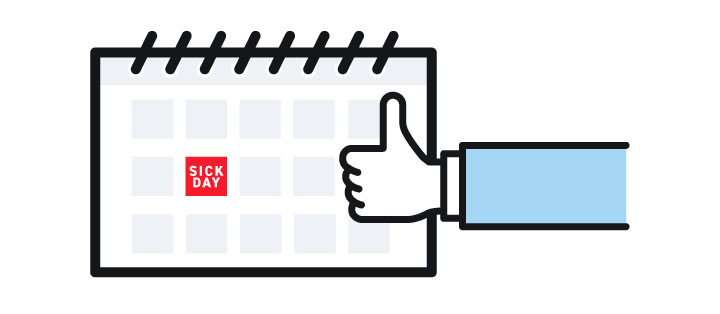There is nothing that screams “sick days” like January after the holidays. The CDC tells us this year is going to be a doozy, so companies should stock up on tissues and hand sanitizer.
While workers may feel pressure to come into work even when they’re ill, working sick actually costs companies more than if sick workers stayed home. As we head into the worst of flu season, here’s why companies should provide—and employees should use—sick days.
Understanding Sick Time

Sick days are paid time off that the employer provides as a worker benefit. Currently, 65% of workers receive sick time, but employees frequently blow off this benefit. In 2018, Americans averaged just 2.5 sick days, and that number has stayed low even though workers are less healthy than in past generations. In fact, 90% of the workforce say they’ve felt pressure to come to work sick.
It should be noted that these numbers don’t take into account the 45% of Americans who have no paid time off. Freelancers and part-time workers may not have this benefit, which means if they don’t work, they aren’t paid. There is currently no federal law requiring companies to provide paid time off. State jurisdictions vary. CNBC reports there are currently 11 states that require private employers to offer sick leave.
Why is there so much agonizing about sick time? The Society for Human Resource Management (SHRM) says nine out of every 10 employees admit to going to work sick, fearing manager reprisals, a negative performance review, or feeling like their workloads are too large to take time off. But SHRM says the prevailing reason employees don’t take time off is money. They either don’t have paid time off, or they’ve used it and they cannot take time off without pay.
No matter the reason, we’re working sick and potentially infecting other workers. Why should employers care as long as employees show up to do the job, right?
The Big Cost of Flu Season
January 2020 launched with a warning from the Centers for Disease Control (CDC) that this year’s flu season will be the worst in decades. You could almost hear the sigh from employers and insurance actuaries as they began to brace themselves for call-offs and insurance claims.
Now consider: The nation has 30 million uninsured and 44 million underinsured individuals. Many of these people are working without the benefits necessary to care for their families. With healthcare costs growing faster than the average income in most states, how do those without insurance cope with winter colds and flu? The answer is that they probably go to work and infect coworkers or perhaps make a trip to the ER with their credit card. It’s an untenable situation—and not just for workers: The Journal of Occupational and Environmental Medicine reports that working sick costs the U.S. $160 billion each year in lost productivity. Not only is the sick worker not as productive, but failing to take the time off that they need could make their illness last longer and, particularly in the case of the cold and flu, spreads germs that reduce the productivity of other workers. Fast Company says, “Low engagement levels per task limit the quality of employee outputs and their efficiency, which means mistakes happen and productivity suffers.”
But what about the direct costs of the flu season? The CDC says flu season outpatient care and hospitalizations cost the U.S. around $10.4 billion each year, and somewhere between 5% and 20% of the entire U.S. population will get the flu this year.
Prevention is key to lowering these numbers. This means both preventing illness before it occurs and stopping the spread of highly contagious germs by keeping them confined. Sick workers may think they’re doing the right thing by toughing it out and coming to work, but employers should recognize that this lowers the productivity of the entire organization because it causes more workers to fall ill.
How can employers change their approach to mitigate the risk to workplace productivity during the cold and flu season this year? The answer is to recognize and change the pressure from management to keep working through illness.
Why Employees Go to Work Sick
Why do sick people come to work anyway? Heavy workloads and an anti-absence culture can make workers feel like they need to keep working. For freelancers or those without benefits, there are often no other options—you work or you lose money. But for employers that offer sick time, a reassessment of attitudes around that benefit is in order.
The data shows it’s counterproductive to work sick, but there is still a sense that a sick worker is a slacker. This has led us to a cultural norm of presenteeism, which is when workers show up sick or struggling with something else that prevents them from operating at full capacity. According to the Virgin Pulse Global Challenge, this costs employers an average loss in productivity of 57.5 days per year for each employee.
While employee absences are easy to measure, understanding the lack of productivity that comes with being sick is harder. The Virgin study said the cost of lost productivity is much higher than the cost of absenteeism ($150 billion); when compiling stats from the U.S., U.K., and Australia, presenteeism costs employers $1,500 billion.
Creating a Culture That Supports Sick Time

The first step toward creating a culture that supports sick time is recognizing the problem. Employers must make managers aware that the cost of working sick is higher than staying home and getting better.
HR Managers should consider whether disciplinary actions associated with absenteeism are contributing to the problem. Evaluate your paid time off policies to determine whether they are counterproductive to a culture of wellness.
You can also present new workplace policies supporting the sick day to your workers. Help managers and employees understand the organization’s support of keeping germs at home. Encourage managers to lead by example when sick and let them know that emergencies can be handled by phone, video, email, or instant message. In daily practice, send sick workers home and support them by offering paid time off if you don’t already.
Elevating work-from-home policies or increasing sick time are just two ways employers can change their approach and alleviate presenteeism.
Promoting Wellness in Your Company

The image of the dedicated worker as someone who comes in even when they’re sick is not appropriate in light of this overwhelming evidence. There is enough data that shows the valiant effort of these employees costs you more in the long run. Employers should instead focus on work-life balance and creating a healthy workplace where employees function at the peak of their mental and physical capacities.
Corporate Wellness Magazine calls for a:
“Rapid evolution of the U.S. workplace wellness industry characterized by innovative solutions for managing health care costs that serve the increasing need for proactive ownership of well-being.”
Focusing your corporate culture on health may be a relatively new trend, but a recent study by ClassPass shows 75% of professionals say the employer has at least some responsibility to contribute to the health and wellbeing of their workers. However, there is a huge gap in how employers perceive their wellness offerings versus how employees perceive these efforts. A recent study by Aetna showed:
- 70% of employers say they believe they offer reasonable access to health and wellness benefits, but only 23% of workers agree with that assumption
- 82% of workers around the world are concerned that mental health issues could impact their work
- 25% of employees say their companies provide them with enough support for their mental health
Whether or not your company offers a professional wellness program, there are plenty of ways to promote a healthy culture in your organization. The first step is to tackle the issue of working sick head-on, but beyond that, even small companies can take steps to improve their approach. Chron Small Business suggests:
- Start by appointing a Wellness Coordinator and giving him or her the tools they need to develop healthy initiatives. Talk with your insurance carrier to determine what services they offer in support of these initiatives.
- Promote a culture of wellness by advertising initiatives in the employee newsletter, corporate intranet, or if the company is small, bulletin board fliers to get employees on board.
- Hold contests to promote employee health through daily exercise or healthier diets.
- Hold training or educational events about ways to improve health. Cooking classes or discussions about nutrition and exercise—or even small lunch-and-learns on eye strain for computer programmers—are all ways companies can teach workers new skills and remind them that their health matters.
- Make wellness important from day one, starting with orientation. Talk about wellness initiatives with new employees to create a ripple effect of interest across the organization.
- Set up a wellness library with videos and research about improving health.
Fast Company says, “Employees who take care of themselves and are encouraged to do so by their leaders are those that are the most productive and engaged.” That’s why employers should take note of the clear benefits of sick days.
The Benefits of Paid Sick Days
The National Association of Social Workers is on board with employee sick days. They report the following benefits of worker paid time off proven by empirical evidence. Paid sick days:
- Improve the economy and corporate bottom line
- Reduce the exorbitant costs of employee turnover
- Reduce the risk of workplace contagion
- Improve worker and company productivity
The CDC says 66% of employers that offer employee wellness programs report an increase in worker productivity. The statistics are overwhelming that “Paid Sick Days Are Good for Business”:
- Employee retention improves when paid sick time is offered. This is particularly true in industries where turnover is traditionally high. No one wants a food service employee to come to work sick, yet this industry is one of the worst for offering paid time off for illness.
- Working adults with no paid sick time are twice as likely to have high medical expenses. This usually entails a trip to the hospital emergency room, a treatment that is the most costly for individuals, employers, and hospitals. These ER trips often replace routine preventative care, in turn creating higher healthcare costs for everyone.
The National Partnership for Women & Families studied the effect on employers after they began offering paid time off for illness and found:
- Two years after New York City passed an ordinance requiring employers to offer paid leave, a poll of companies showed that 86% of business owners said they supported the law.
- Connecticut was one of the first states to require paid time off. Years later, they found that there was no negative impact on growth or the company bottom line after offering these benefits.
- Paid sick leave has also been shown to improve economic growth. New York City showed an increase in business growth, higher labor participation, lower consumer prices, and lower unemployment. In Seattle, total wages in the city went up and no negative economic impact was reported.
The numbers seem to prove that employee sick days are a good idea for everyone involved. Companies benefit from higher productivity and a healthier workplace. Turnover will go down and recruiting numbers could increase. Employees will be happier, and this will all translate into better corporate profits and a stronger economy.
Artisan Talent believes in strong corporate cultures where workers are valued, healthy, and productive. These core beliefs benefit our employer partners as we work together toward the ultimate goal: a strong, engaged workforce to improve your bottom line. Call us to find out how we can help your company in 2020.




